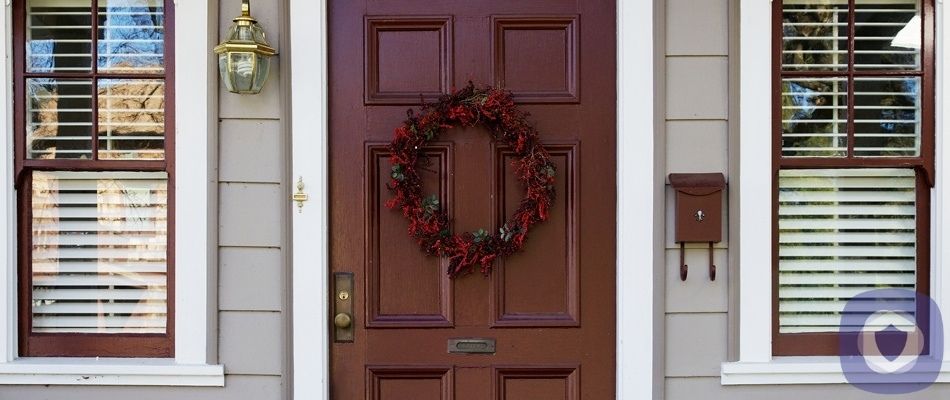The front door is your first line of defense from a potential break-in. Statistics have shown that up to 34% of burglaries are through the front door. For this reason, it is always a bright idea to take a look at your current front door security for ways that you can improve your security.
This article will cover several ways you can improve your front door security, including installing additional security features or improving old ones. If you’re interested in how to improve your front door security, keep reading for more information.
1. Peepholes
A peephole is a reasonably inexpensive and easy-to-install security feature for your front door. It is ideal for those who do not have a window that can see the outside of the front door. A peephole allows you to look out to your front door safely to see if it is safe to open.
Peepholes are made from a variety of materials, including steel, wood, or fiberglass. They can be simple in design, or they can be ornate. When installing a peephole, remember to install it at a height that all members of your family will be able to use it from. If you have children, you may want to consider installing two peepholes, one at adult height and one at child height.
2. Reinforcing Your Door
There are a few pretty simple ways to reinforce your door to prevent a break-in. First, consider upgrading your existing locks. If you have an older lockset, they may be potentially not as secure as you may think. Also, remove any ‘hidden keys’ that you have outside. If you have a deadbolt, consider replacing it with one that has a longer throw arm.
Secondly, check the strike plates. Check to make sure the screws installed in the strike plate are at least 3 inches. You may want to consider replacing the strike plates with more heavy-duty ones and require four screws rather than just the standard two.
The door itself is also worth consideration. A steel door or solid wood door would be much stronger than a hollow-core door. Ideally, you want a solid door for your front door.
3. Replacing the Strike Plate Screws
As mentioned above, it is always a good idea to replace the screws in your strike plates. Short screws are not as secure. Thankfully they are straightforward to switch out.
Begin by removing the old screws. Switch to screws that are at least 3 inches long. You will need screws that will fit in the strike plate holes and have a flat head. If you also replace the strike plate, you may need to chisel the space for the new strike plate and predrill the new screw holes.
When driving in the screws, be sure to angle them slightly back to catch the interior framing. The video below gives a clear view of how easy this is.
4. Getting the Right Lock
You want to be sure that your door lock is made specifically for exterior doors for your front door. Exterior locks are made with a higher quality of materials to withstand the weather and force.
The standard lock type is a cylinder lock. Cylinder locks are also potentially easy to be broken open using bumping techniques. A double cylinder lock requires a key on both sides of the door but can pose a safety risk during a fire.
If you are comfortable with technology, you could also consider a smart lock, which uses Bluetooth or z-wave to operate. You can open and monitor smart locks remotely. They may also feature a keypad in addition to a key.
5. Deadbolts
Deadbolts are the most common type of lock used for residential front door security. To open a deadbolt, you need a key both from the outside. From the inside, you can engage a deadbolt with a thumb-turn button.
Grades are awarded to deadbolts by the amount of force they can withstand. The grades go from 1 through 3. A grade 1 deadbolt lock is the highest level of security and quality that can be awarded to a deadbolt. Now, a grade three deadbolt will have a lesser level of protection, but it is still at an acceptable level for home security use.
Benefits
Unlike regular locks, the mechanism inside a deadbolt doesn’t contain a spring. It is more difficult to open than a typical doorknob lock when you don’t have the key.
You can use a deadbolt in conjunction with your doorknob lock to provide your front door an extra layer of security.
Single vs. Double Cylinder
Deadbolts can have either a single or double cylinder.
Single-cylinder is the more common type, where the key is only required from the outside to open. On the interior side of the lock, the lock can be engaged with a thumb-turn button.
A double cylinder deadbolt requires a key from both sides of the door to move the lock. This mechanism inside a double cylinder makes it impossible for a burglar to force the lock, but it does have some drawbacks. This type of lock may slow down a family attempting to leave the house in the case of a fire or some other emergency.
You may want to consider a double cylinder lock if the door is close to a window.
6. Doorbell Cameras
A newer type of front door security is a doorbell camera. It is an electric doorbell that comes equipped with a wide-angle security camera. Some common examples are the Google Nest Doorbell and the Ring Doorbell.
In most cases, the video feed is paired with your phone so that you can see who is at your front door from any of your devices. Some doorbell cameras also include an intercom system, letting you talk to whoever is at your entry door, whether you are home or not.
It should be noted that most doorbell cameras do require wi-fi to work.
7. Security Bars
A door security bar is an additional level of front door security past the locks. The most common type of security bar for your front door is one where one side has a fork, and the other has a rubber foot. The fork side is positioned under the doorknob, while the foot is on the floor.
In the case of a break-in, the security bar becomes a wedge to help keep a would-be burglar from being able to kick in your door.
The second variety of security bars can be used to hold a patio door closed. This type is usually a straight stick with a rubber nob on each end.
Security bars can be rated to take up to 350lbs of force. They can be easily found on Amazon or in local stores.
8. Home Security Systems
There is a wide range of security systems that you can choose from to create the highest level of security for your home.
A monitored system is a home security system watched by a professional company 24 hours a day to give homeowners peace of mind. Monitored systems not only have cameras, but they also can detect fires and other emergencies.
Once an emergency is detected, a monitored system can automatically alert a security team or emergency responders to see to your emergency. Monitored systems are often installed by the security company and carry a monthly fee for the monitoring service.
An unmonitored security system is an alarm system that a professional company does not watch. Often this means it is a system that you instal and monitor yourself. Suppose part of your security system is triggered, such as if a break-in is detected, it’ll be up to you to alert the appropriate authorities.
Unmonitored systems are often more affordable, but they come at the risk of you cannot monitor your system 24/7. Also, in some emergencies, you may not be able to alert authorities.
Wrapping Up Your Front Door Security
There are many inexpensive ways to upgrade the security of your front door. The best action is to look at your current security setup and look for potential weak spots or places you can improve.
This article has been reviewed and approved by Officer Banta.

Officer Banta is the official SecurityNerd home security and safety expert. A member of the Biloxi Police Department for over 24 years, Officer Banta reviews all articles before lending his stamp of approval. Click here for more information on Officer Banta and the rest of our team.

